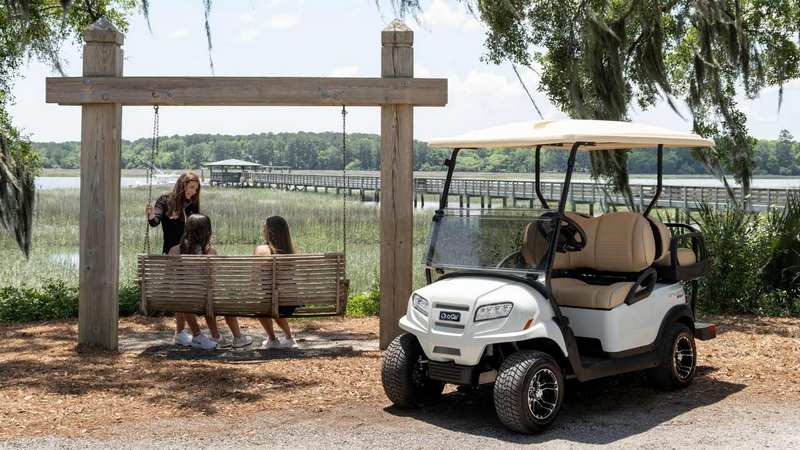Content Menu
● The Basics of Golf Cart Electric Motors
>> Types of Electric Motors in Golf Carts
● Components of a Golf Cart Electric Motor
>> Stator
>> Rotor
>> Commutator
>> Brushes
>> Bearings
● How the Electric Motor Operates
● The Role of the Controller
>> Speed Control
>> Direction Control
● Efficiency and Performance
>> Regenerative Braking
>> Torque Characteristics
>> Low Maintenance
● Advancements in Golf Cart Motor Technology
>> Brushless DC Motors
>> High-Efficiency Magnets
>> Smart Motor Controllers
● Environmental Impact
>> Reduced Noise Pollution
>> Energy Efficiency
● Maintenance and Care
● Future Trends
>> Integration of IoT Technology
>> Improved Battery Technology
>> Solar-Powered Charging
● Conclusion
● Frequently Asked Questions
>> 1. How long do golf cart electric motors typically last?
>> 2. Can I upgrade my golf cart's electric motor for better performance?
>> 3. How does the power output of an electric golf cart motor compare to a gas-powered engine?
>> 4. Are there any special considerations for using electric golf carts in extreme weather conditions?
>> 5. How does regenerative braking work in golf cart electric motors?
Golf carts have become an integral part of the golfing experience, providing convenience and comfort to players as they navigate the course. At the heart of these vehicles lies a sophisticated piece of technology: the electric motor. This article delves into the intricate workings of a golf cart electric motor, exploring its components, functionality, and the science behind its operation.

The Basics of Golf Cart Electric Motors
Electric golf carts are powered by electric motors that convert electrical energy into mechanical energy. These motors are responsible for propelling the cart forward and backward, allowing golfers to traverse the course with ease.
Types of Electric Motors in Golf Carts
There are two main types of electric motors used in golf carts:
1. DC (Direct Current) Motors
2. AC (Alternating Current) Motors
DC motors have been the traditional choice for golf carts due to their simplicity and ease of maintenance. However, AC motors are gaining popularity in modern golf carts, especially in heavy-duty models, due to their efficiency and performance advantages.
Components of a Golf Cart Electric Motor
To understand how a golf cart electric motor works, it's essential to familiarize ourselves with its key components:
1. Stator
2. Rotor
3. Commutator
4. Brushes
5. Bearings
Stator
The stator is the stationary part of the motor that contains wire windings. These windings create a magnetic field when electricity flows through them.
Rotor
The rotor is the rotating part of the motor, typically made of a shaft with attached magnets or electromagnets. It interacts with the magnetic field created by the stator to generate motion.
Commutator
In DC motors, the commutator is a cylindrical component attached to the rotor. It helps reverse the direction of current flow in the rotor windings, maintaining continuous rotation.
Brushes
Brushes are stationary conductors that make contact with the commutator, transferring electrical current from the power source to the rotor.
Bearings
Bearings support the rotor and allow it to rotate smoothly within the motor housing.

How the Electric Motor Operates
The operation of a golf cart electric motor can be broken down into several steps:
1. Power Supply: When the golf cart is turned on, electrical energy from the battery pack is supplied to the motor.
2. Magnetic Field Generation: The electrical current flowing through the stator windings creates a magnetic field.
3. Rotor Interaction: The rotor's magnets or electromagnets interact with the stator's magnetic field, causing the rotor to rotate.
4. Commutation: In DC motors, the commutator and brushes work together to reverse the current flow in the rotor windings at specific intervals, maintaining continuous rotation.
5. Mechanical Output: The rotation of the rotor is transferred to the golf cart's wheels through a series of gears and shafts, propelling the cart forward or backward.
The Role of the Controller
The golf cart's motor controller plays a crucial role in regulating the performance of the electric motor. It acts as an intermediary between the battery and the motor, controlling the amount of power delivered based on input from the accelerator pedal.
Speed Control
The controller allows for precise speed control by adjusting the voltage and current supplied to the motor. When the accelerator is pressed, the controller increases the power output, causing the motor to spin faster and the cart to accelerate.
Direction Control
The controller also manages the direction of rotation, enabling the golf cart to move forward or reverse. This is typically achieved by reversing the polarity of the current supplied to the motor.
Efficiency and Performance
Golf cart electric motors are designed for optimal efficiency and performance. Several factors contribute to their effectiveness:
Regenerative Braking
Many modern golf carts incorporate regenerative braking systems. When the brakes are applied, the electric motor acts as a generator, converting some of the cart's kinetic energy back into electrical energy. This energy is then stored in the battery, improving overall efficiency.
Torque Characteristics
Electric motors provide instant torque, allowing golf carts to accelerate quickly from a standstill. This characteristic makes them well-suited for the stop-and-go nature of golf course navigation.
Low Maintenance
Compared to internal combustion engines, electric motors have fewer moving parts, resulting in lower maintenance requirements and increased reliability.
Advancements in Golf Cart Motor Technology
The field of golf cart electric motors is continuously evolving, with new technologies emerging to enhance performance and efficiency:
Brushless DC Motors
Brushless DC motors are gaining popularity in golf carts due to their improved efficiency and reduced maintenance needs. These motors eliminate the need for brushes and commutators, resulting in less wear and tear.
High-Efficiency Magnets
The use of high-performance magnets, such as neodymium magnets, in electric motors has led to increased power output and improved efficiency.
Smart Motor Controllers
Advanced motor controllers with microprocessor technology offer features like regenerative braking, battery management, and programmable performance settings.

Environmental Impact
One of the significant advantages of electric golf cart motors is their minimal environmental impact. Unlike gas-powered carts, electric carts produce zero emissions during operation, contributing to cleaner air on golf courses.
Reduced Noise Pollution
Electric motors are significantly quieter than their gas-powered counterparts, enhancing the golfing experience by reducing noise pollution on the course.
Energy Efficiency
Electric motors are highly efficient in converting electrical energy into mechanical energy, with some models achieving efficiency ratings of over 90%.
Maintenance and Care
To ensure optimal performance and longevity of a golf cart electric motor, regular maintenance is essential:
1. Keep the motor clean and free from debris
2. Check and tighten electrical connections periodically
3. Inspect brushes (in DC motors) for wear and replace as needed
4. Lubricate bearings according to manufacturer recommendations
5. Monitor battery health and charge levels
Future Trends
The future of golf cart electric motors looks promising, with several exciting trends on the horizon:
Integration of IoT Technology
The Internet of Things (IoT) is making its way into golf cart technology, allowing for remote monitoring and diagnostics of electric motors and other cart components.
Improved Battery Technology
Advancements in battery technology, such as lithium-ion batteries, are leading to increased range and performance for electric golf carts.
Solar-Powered Charging
Some golf courses are exploring the use of solar panels to charge electric golf carts, further reducing their environmental impact.
Conclusion
The electric motor is the unsung hero of the modern golf cart, providing efficient, reliable, and environmentally friendly propulsion. By converting electrical energy into mechanical motion, these motors enable golfers to navigate courses with ease and comfort. As technology continues to advance, we can expect even more efficient and powerful electric motors to enhance the golfing experience in the years to come.
Understanding how a golf cart electric motor works not only satisfies our curiosity but also helps us appreciate the engineering that goes into these seemingly simple vehicles. Whether you're a golf enthusiast or simply interested in electric vehicle technology, the world of golf cart electric motors offers a fascinating glimpse into the intersection of sports and sustainable transportation.

Frequently Asked Questions
1. How long do golf cart electric motors typically last?
Golf cart electric motors are known for their durability and can last anywhere from 10 to 20 years with proper maintenance. The lifespan depends on factors such as usage frequency, maintenance practices, and environmental conditions. Regular cleaning, inspection, and timely repairs can significantly extend the life of an electric motor.
2. Can I upgrade my golf cart's electric motor for better performance?
Yes, it's possible to upgrade your golf cart's electric motor for improved performance. Upgrades can include installing a higher voltage motor, upgrading to a more powerful controller, or switching to a brushless DC motor. However, it's important to consider the compatibility with your cart's existing components and consult with a professional to ensure safe and effective upgrades.
3. How does the power output of an electric golf cart motor compare to a gas-powered engine?
Electric golf cart motors typically provide instant torque and smooth acceleration, which can feel more powerful at low speeds compared to gas engines. While gas engines may have higher horsepower ratings, electric motors often deliver better overall performance for the stop-and-go nature of golf course driving. Additionally, electric motors are generally more efficient in converting energy into motion.
4. Are there any special considerations for using electric golf carts in extreme weather conditions?
Extreme temperatures can affect the performance of electric golf cart motors and batteries. In cold weather, battery capacity may be reduced, potentially limiting range. Hot weather can cause motors to run hotter, potentially leading to reduced efficiency or overheating. It's important to store carts in temperature-controlled environments when possible and allow for proper warm-up or cool-down periods in extreme conditions.
5. How does regenerative braking work in golf cart electric motors?
Regenerative braking in golf carts works by using the electric motor as a generator when slowing down or going downhill. When the brake is applied, the motor reverses its operation, converting the cart's kinetic energy into electrical energy. This energy is then fed back into the battery, helping to recharge it and extend the cart's range. This process not only improves efficiency but also reduces wear on the mechanical brakes.











































